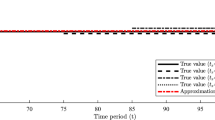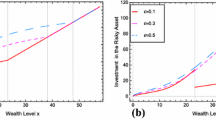Abstract
We investigate both of analytical and numerical solutions of retirees’ spending and investment decisions. We use a dynamic and realistic recursive utility setting which includes the standard expected utility setting as a special case. We find that recursive utility is superior to expected utility in terms of predicting retirees’ consumption data. In addition to stock and bond investment decisions, we explicitly include housing decision. Our setting includes the setting without housing as a special case. We estimate retiree decisions numerically through simulations. We provide both of analytical and numerical comparative analysis which shows that some of the analytical dependencies are found to be weak numerically. For example, although marginal propensity to consume depends on the parameter of intertemporal substitution analytically, this dependence is found to be weak numerically. These differences show the importance of providing both of analytical and the numerical solutions. Our analytical solution could be useful for future studies to estimate some model parameters, to evaluate different elderly related policies, to quantify the welfare effects of different decisions and to analyze the parameter related issues such as the interchangeability of some parameters.


Similar content being viewed by others
Notes
RU denotes recursive utility, EU symbolizes expected utility, C stands for consumption, B represents bond holdings and S denotes the stock holdings and EIS denotes the elasticity of intertemporal substitution throughout this paper.
We assume equal lending and borrowing rates.
e.g. Yao and Zhang (2005)
Yao and Zhang (2012) calculated the average stock proportion in liquid financial assets as 0.41 for the people aged 65-75. When we set β at 0.955, we obtain the value of 42% for the average stock proportion and this value lines up with the corresponding standard estimates.
Yao and Zhang (2005) does not use recursive utility, thus it does not have the parameter 𝜖.
Data refers to sample averages of key variables for households in the Survey of Consumer Finances between 1989 and 2001
References
Agarwal S, Mazumder B (2013) Cognitive abilities and household financial decision making. Am Econ J Appl Econ 5(1):193–207
Aldrich E M, Kung H (2017) Computational methods for production-based asset pricing models with recursive utility, Economic Research Initiatives at Duke Working Paper 87
Almenberg J, Save-Soderbergh J (2011) Financial literacy and retirement planning in Sweden. J Pension Econ Finance 10:585–598
Andreasen M (2009) Explaining macroeconomic and term structure dynamics jointly in a non-linear DSGE model, Working Paper
Andreasen M, Jorgensen K (2019) The importance of timing attitudes in consumption-based asset pricing models, J Monet Econ. Forthcoming
Amisano G, Tristani O (2010) A DSGE model of the term structure with regime shifts, Manuscript
Arias E (2006) United states life tables. Natl Vital Stat Rep 54:1–40
Attanasio O P, Weber G (1993) Consumption growth, the interest rate, and aggregation. Rev Econ Stud 60:631–649
Attanasio O P, Weber G (1995) Is consumption growth consistent with Intertemporal optimization? evidence from the consumer expenditure survey. J Polit Econ 103:1121–1157
Aydilek A (2013) Habit formation and housing over the life cycle. Econ Model 33:858–866
Aydilek A (2016) The allocation of time and puzzling profiles of the elderly, Economic Modelling, in press
Aydilek A, Aydilek H (2018) Parameter interchangeability under recursive utility with housing. J Econ Finan 42(4):807–817
Bansal R, Yaron A (2004) Risk for the long run: a potential resolution of asset pricing puzzles. J Financ 59:1481–1509
Beaudry P, van Wincoop E (1995) The Intertemporal elasticity of substitution: an exploration using US panel of state data. Economica 63:495–512
Bhamra H S, Uppal R (2006) The role of risk aversion and Intertemporal substitution in dynamic consumption portfolio choice with recursive utility. J Econ Dyn Control 30:967–991
Blake D, Wright D, Zhang Y (2014) Age-dependent investing: optimal funding and investment strategies in defined contribution pension plans when members are rational life cycle financial planners. J Econ Dyn Control 38(1):105–124
Chiang S L, Tsai M S (2016) Analyzing an elder’s desire for a reverse mortgage using an economic model that considers house bequest motivation, random death time and stochastic house price. Int Rev Econ Financ 42:202–219
Cocco J (2005) Portfolio Choice in the Presence of Housing. Rev Financ Stud 18:535–567
Cocco J, Gomes F J, Maenhout P J (2005) Consumption and Portfolio Choice over the Life-Cycle. Rev Financ Stud 18:491–533
Constantinides GM, Donaldson JB, Mehra R (2002) Junior can’t borrow: a new perspective on the equity premium puzzle. Q J Econ 117:269–296
Dumas B, Uppal R (2001) Global diversification, growth and welfare with imperfectly integrated markets for goods. Rev Financ Stud 14:227–305
Epstein L G, Zin S (1989) Substitution risk aversion and the temporal behavior of consumption and asset returns: A theoretical framework. Econometrica 57:937–969
Epstein L G, Zin S (1991) Substitution risk aversion and the temporal behavior of consumption and asset returns: an empirical analysis. J Polit Econ 99:263–286
Flavin M, Nakagawa S (2008) A model of housing in the presence of adjustment costs: a structural interpretation of habit persistence. Am Econ Rev 98(1):474–495
Fernandez-Villaverde J, Krueger D (2011) Consumption and saving over the life cycle: how important are consumer Durables?. Macroecon Dyn 15:725–770
Giuliano P, Turnovsky S (2003) Intertemporal substitution risk aversion, and economic performance in a stochastically growing open economy. J Int Money Financ 22:529–556
Gomes F, Michaelides A (2005) Optimal life-cycle asset allocation: understanding the emprical evidence. J Financ 60:869–904
Grossman SJ, Laroque G (1990) Asset pricing and optimal portfolio choice in the presence of illiquid durable consumption goods. Econometrica 58(1):25–51
Grossman S J, Melino A, Shiller RJ (1987) Estimating the continuous-time consumption-based asset-pricing model. J Bus Econ Stat 5:315–327
Guvenen F (2009) A parsiomonious macroeconomic model for asset pricing. Econometrica 77:1711–1750
Hall RE (1988) Intertemporal substitution in consumption. J Polit Econ 96:339–357
Hastings J, Mitchell OS (2011) How financial literacy and impatience shape retirement wealth and investment behaviors. Journal of Pension Economics and Finance :1–20
Heiberger C, Ruf H (2019) Epstein-zin utility, asset prices, and the business cycle revisited, german economic review. https://doi.org/10.1111/geer.12186
Kaltenbrunner G, Lochstoer L A (2010) Long-run risk through consumption smoothing. Rev Financ Stud 23:3190–3224
Li W, Yao R (2007) The life-cycle effects of house price changes. J Money, Credit, Bank 39(6):1375–1409
Mehra R, Prescott E C (1985) The equity premium: a puzzle. J Monet Econ 15:145–161
Megbolugbe I, Jarjisu S, Shilling J (1997) Oh, Yes, The elderly will reduce housing equity under the right circumstance. J Hous Res 8:53–74
Motohiro Y (2016) Portfolio choice in retirement: health risk and the demand for annuities, housing, and risky assets. J Monet Econ 80(C):17–34
Ogaki M, Reinhart C M (1998) Measuring Intertemporal Substitution: the role of durable goods. J Polit Econ 106:1078–1098
Rudebush G D, Swanson E T (2008) Examining the bond premium puzzle with a DSGE model. J Monet Econ 55:111–126
Schroder M, Skiadas C (1999) Optimal consumption and portfolio selection with stochastic differential utility. J Econ Theory 89:68–126
Schroder M, Skiadas C (2003) Optimal lifetime consumption-portfolio strategies under trading constraints and generalized recursive preferences. Stochastic Processes and Their Applications 108:155–202
Spicer A, Stavrunova O, Thorp S (2016) How portfolios evolve after retirement: evidence from Australia. Econ Rec 92(297):241–267
Venti S F, Wise D (2004) Aging and housing equity: Another look, perspectives on the economics of aging. In: Wise D (ed). Univ Chicago Press, pp 127–80
Wang C, Wang N, Yang J (2016) Optimal consumption and savings with stochastic income and recursive utility. J Econ Theory 165:292–331
Weil P (1989) The equity premium puzzle and the risk free rate puzzle. J Monet Econ 24:401–421
Weil P (1990) Non-expected utility in macroeconomics. Q J Econ 105:29–42
Yao R, Zhang H (2005) Optimal consumption and portfolio choices with risky labor income and borrowing constraints. Rev Financ Stud 18:197–239
Yao R, Zhang H (2012) Optimal life-cycle asset allocation with housing as collateral, Under Review 18
Acknowledgments
We are grateful to Fernando Zapatero and Selale Tuzel for their numerous helpful comments.
Author information
Authors and Affiliations
Corresponding author
Additional information
Publisher’s note
Springer Nature remains neutral with regard to jurisdictional claims in published maps and institutional affiliations.
Appendix
Appendix
Proofs are very long and omitted, but could be provided if requested.
Rights and permissions
About this article
Cite this article
Aydilek, A., Aydilek, H. An optimization model of retiree decisions under recursive utility with housing. J Econ Finan 44, 258–277 (2020). https://doi.org/10.1007/s12197-019-09485-5
Published:
Issue Date:
DOI: https://doi.org/10.1007/s12197-019-09485-5




